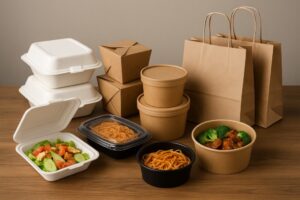In the food service industry, providing customers with delectable meals goes hand in hand with ensuring those dishes reach them in excellent condition. The choice of takeaway containers is crucial not just for customer satisfaction but also for maintaining food quality and safety. To aid business owners and caterers in their selection, herein lies a comprehensive guide to choosing the best containers for takeaway purposes.
Understanding Material Options
Takeaway containers come in various materials, each with unique benefits. Plastic containers are popular due to their durability and typically lower cost. On the other hand, foil trays are ideal for retaining heat, making them suitable for hot meals. Additionally, there are biodegradable and compostable alternatives for those seeking environmentally friendly solutions. Balancing cost, usability, and sustainability is a crucial part of the decision-making process.
Portion Control and Size
When selecting containers, it’s imperative to consider portion sizes. Offering a range of different-sized containers can cater to various menu items and customer preferences, helping to control portions and reduce food waste. An accurately sized container also ensures that food items are not shifting during transportation, which is crucial for presentation and preserving meal integrity.
Sealing and Leak Prevention
A secure seal is necessary to prevent leaks and spills, especially for liquid-based dishes like soups or curries. Containers must have tight-fitting lids that are easy to close but robust enough not to pop open unexpectedly. This not only enhances customer experience but also ensures the safety of delivery personnel.
Insulation and Temperature Control
Retaining the desired temperature of food from the kitchen to the customer’s door is essential. Containers with good thermal properties, such as insulated foam or double-walled designs, help maintain temperatures, keeping hot foods hot and cold foods cold.
Stackability and Storage
An often-overlooked aspect is how well containers stack and store. For efficient space utilisation in both the kitchen and during transport, containers should be stackable without risk of collapsing. Furthermore, they should nest well to minimise the required storage space when not in use.
Customisation and Branding
While practicality is key, takeaway containers also offer an opportunity for branding. Customisable containers with a business logo or design can enhance brand recognition and contribute to a more professional appearance. However, it’s important to balance the cost of customisation with the budget allocated for packaging.
Ease of Use for the Consumer
Container design should also consider the end-user. Features such as easy-open tabs, clarity of the material to view contents, and microwave-safe options can greatly enhance the customer’s convenience and overall experience.
Durability and Strength
A container might tick all the boxes for insulation and size, but if it cannot withstand the rigours of transport, it falls short of requirements. Durability under a variety of conditions, including resistance to cracking or puncturing, is fundamental to protect the product within.
Environmental Impact
Businesses today must be conscious of their environmental footprint. Containers made from recyclable or compostable materials can appeal to eco-conscious consumers and reflect a commitment to sustainability. It’s also important to encourage customers to recycle or dispose of the containers responsibly.
Compliance with Food Safety Standards
Safety is non-negotiable when it comes to food packaging. Containers should meet all relevant food safety standards to ensure they do not interact with the food in ways that could be harmful. Certifications and manufacturer guarantees can provide reassurance in this regard.
Cost-Effectiveness
While the cheapest option may be tempting, it’s important to assess the true cost-effectiveness of takeaway containers. This encompasses not only the unit price but also the durability, impact on customer satisfaction, and potential for repetitive purchases due to higher quality.
The Role of Suppliers in Selection
Choosing the right supplier, such as WF Plastic, is just as important as the containers themselves. Reliable suppliers offer high-quality products, consistent stock, and valuable advice based on industry experience. Developing a relationship with a trusted supplier can lead to more informed choices and potentially better pricing due to volume discounts.
Matching Containers to Menu Items
Finally, the nature of the food being offered should influence container selection. Delicate, presentation-centric dishes may require clear containers, while heartier meals might need sturdier, insulated options. Understanding the specific needs of the menu ensures the chosen containers enhance, rather than detract from, the dining experience.
Conclusion
The choice of takeaway containers is multifaceted, requiring careful consideration of materials, functionality, customer experience, sustainability, and compliance with safety standards. By taking into account these essential factors, food service establishments can provide their customers with high-quality meals that are as enjoyable at home as they are in the dining room. With the right approach and a dependable supplier by their side, businesses can create takeaway solutions that gain customer trust and encourage repeat orders.








